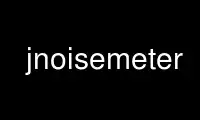
This is the command jnoisemeter that can be run in the OnWorks free hosting provider using one of our multiple free online workstations such as Ubuntu Online, Fedora Online, Windows online emulator or MAC OS online emulator
PROGRAM:
NAME
jnoisemeter - Jnoisemeter is a small app which measure audio test signals.
SYNOPSIS
jnoisemeter [options]
DESCRIPTION
This manual page documents briefly the jnoisemeter
This manual page was written for the Debian distribution because the original program does
not have a manual page.
jnoisemeter is a small app designed to measure audio test signals and in particular noise
signals through Jack Audio Connection Kit.
The simplest use is to measure the S/N ratio of your sound card. If you can calibrate the
input levels of your soundcard it can also be used (with some external hardware) to
measure noise levels of any type of audio equipment, including preamps and microphones.
jnoisemeter has the following filters:
FLAT
No filtering at all, the signal is passed directly
to the detector.
20KHZ
This is 4th order Chebyshev lowpass filter having
a noise bandwidth of exactly 20 kHz. This means
that if the input signal is white noise, the RMS
output level is the same as for a 'perfect' 20 kHz
lowpass filter. This is the normal filter to use for
'unweighted' measurements, as any noise measurement
should always use a well-defined bandwidth.
Future version may use a higher order filter.
IEC A and C
The well-known standard noise weighting filters used
to obtain dB(A) and dB(C) measurements.
ITU-R468
This is a filter optimised for measuring low-level
background noise. It rises 6 dB/oct at low frequencies,
has a peak of around +12 dB at 6.3 kHz, and falls off
radiply after that. It should be used together with the
ITU-R468 detector described below.
ITU-R468 (Dolby variant)
This is the same filter as the previous one with around
5.6 dB less gain. See below for why this exists.
jnoisemeter also provides a DC blocking filter (first order highpass, 5 Hz). This may be
necessary when using the FLAT and 20KHZ filters, the others are DC-blocking anyway.
jnoisemeter has three detectors:
RMS
Root-mean-square (i.e. 'power') meter. The time constant
is 125 ms as per IEC standard, or 1 second in slow mode.
AVERAGE
This measures the average of the absolute value. The one
used in jnoisemeter is actually a VU meter. A 10 times
slower version is also provided.
ITU-R468
This is a 'pseudo-peak' detector designed specifically
to measure noise and S/N ratios. For a peak meter it is
quite slow, as it should be for noise measurements, but
at the same time it is much more sensitive to short
impulsive noise than its speed would suggest.
The original rationale for this was the presence of
impulsive noise (generated by the electromechanical
telephone exchanges of those days) on long analog audio
lines. Today long distance audio lines are all digital,
but a detector such as this one is also ideal to reveal
the typical short noise bursts and 'crackle' originating
in computers and other digital equipment.
All three detectors will show 0.0 dB for a 'digital full scale' sine wave (i.e. peaking
+/- 1.0).
The ITU-R468 standard
This uses both the ITU filter and detector, and is probably the 'best' standardized way to
measure noise. It is used by e.g. the manufacturers of quality microphones, in particular
the European ones. It produces a result that is on average about 10 dB higher than an A-
weighted RMS measurement.
There is a 'variation' of this standard called 'ITU-ARM'. This was devised by Dolby Inc.
at the time they were selling noise reduction technology for magnetic tape recorders. The
traditional A-weighted measurements would show very little S/N ratio improvement when
using Dolby-B. For this reason Dolby wanted to adopt the ITU-R468 method (which shows the
difference quite clearly) but without the apparent 10 dB loss in S/N ratio as this was
deemed bad for marketing. The solution adopted was to lower the gain of the filter, and
use an average detector instead of the pseudo-peak one. Despite the 'ITU-ARM' name this is
not an official standard, and not approved by the ITU.
OPTIONS
-h
Display short info
-n <name>
Name to use as jack client
SEE ALSO
jackd(1).
Use jnoisemeter online using onworks.net services
